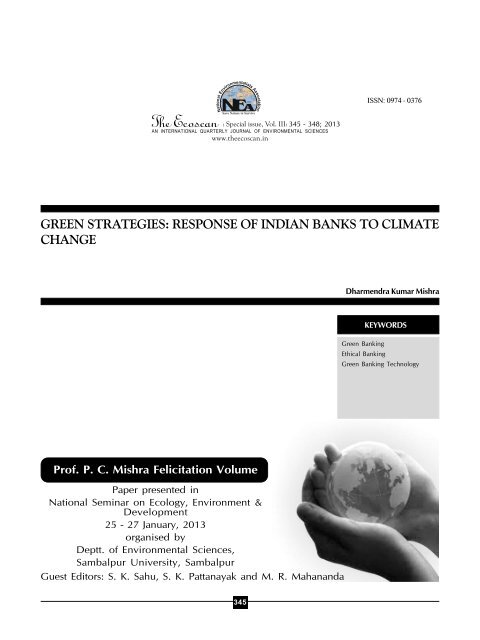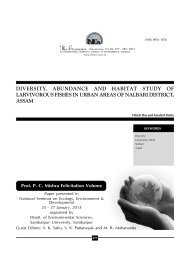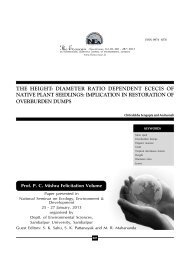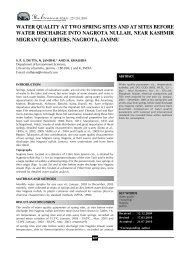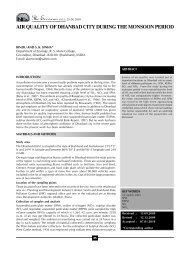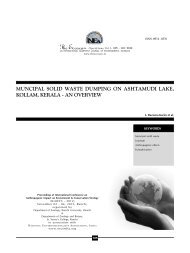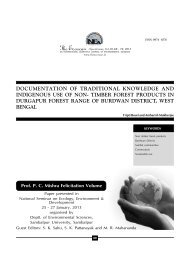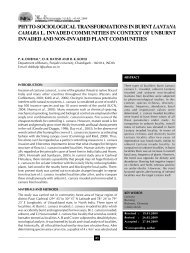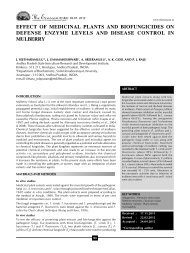Dharmendra Kumar Mishra.pmd - An International Quarterly Journal ...
Dharmendra Kumar Mishra.pmd - An International Quarterly Journal ...
Dharmendra Kumar Mishra.pmd - An International Quarterly Journal ...
You also want an ePaper? Increase the reach of your titles
YUMPU automatically turns print PDFs into web optimized ePapers that Google loves.
RESPONSE OF INDIAN BANKS TO CLIMATE CHANGETimes, 26/02/2012)Green banking - The conceptBank’s participation in sustainable development takes in theform of Green Banking. Environmental protection andsustainable ecological balance have emerged as significantthemes of the twenty first century as increasing number of‘green technologies’ are finding their ways into the variousfunctional areas including banking. In a globalised economyindustries and firms are bound to be affected by stringentenvironmental policies. Since banks provide funds to them,they can come across severe credit and liability risks undersuch environmental policies, which has evolved the conceptof green banking. (Bihari, 2011) Earlier, for banks only colourof money was green- no longer money only, now they arethinking of green branches, green projects, green return, greenindustries, green balance sheet, recycled papers for chequebooks etc. Green banking means promoting environmentalfriendly practices and reducing carbon footprint from bankingactivities. To aid the reduction of external carbon emission,banks are financing green technology and pollution reducingprojects. (Bahl, 2012) Green banking is also called as ethicalbanking, which consider all the factors before considering aloan - whether the project is environment friendly and hasany implications in the future. A company will be awarded aloan only when all the environment safety standards arefollowed. Green banking is a practical approach for futuresustainability of our earth. Banking sector is generallyperceived as environment friendly and do not impact theenvironment much through their own ‘internal’ operations,but in view of the relationship between the banking sectorand the firms who are users of banks’ products, the ‘external’impact on the environment through these entities is substantial.Banks plays a pivotal role in financing different projects byputting certain standards of lending for industries and firms toadopt CDM. A green bank like other normal bank takes allsocial/environmental/ecological considerations, not only inits operations but also in financing decisions and projectapproval to protect the environment and conserve naturalresources. It also insists business people to do environmentalfriendly business, avoids use of papers and relies on online/electronic transactions leading to less cutting of trees. In greenbanks interest on loan is comparatively less with normal banksas its gives importance on environment friendly factors in theform of ecological gains. Under green banking, banks arealso thinking for green loans like- investing in projects likerecycling, farming, technology development, wastemanagement etc. Following three types of projects areencouraged under green banking, which will be audited by athird party expert (person/institute).i) Projects with sustainable development and using naturalrenewable resources.ii) Projects which prevent and control pollution and minimizewaste.iii) Projects which protect human health, bio-diversity,occupational health and safety and efficient production,delivery and use of energy.Go green - Indian banking industryGreen banking requires a paradigmatic change in thinkingabout economics, business and finance. Its success would begreater if all governments started to revise their economicparadigms from being ‘monetary economics’ to ‘ecologicaleconomics’ and begin to transform their accounting principlesfrom purely being financial into ecological/operational energyaccounting patterns. It will help in ecological balance. StateBank of India (SBI) as part of its Green Banking Policy has setup three wind mills to generate 15 MW of power in TamilNadu, Maharashtra and Gujarat for its own consumption, firstin country to think of generating green power as a directsubstitute to polluting thermal power and implement therenewable energy project for captive use. These captiverenewable power plants are first of its kind in India. If someoneis interested to construct a new house through home loanfrom SBI, called green housing, then he/she will enjoy severalbenefits like, 5% concession in margin, 0.25% concession ininterest rate and waiver of processing fees, only if his/herhousing project (plan and estimate) is approved/ rated by IndianGreen Building Council (IGBC). Introduction of Green ChannelCounter (GCC) at its retail branches of from 01/07/2010 (SBIday) provide three basic service to its customers, i.e. cashdeposit, cash withdrawal and fund transfer up to Rs.40,000 aday which reduces the use of paper and transaction time.A large number of Small Scale Industries (SSIs) functioning inunorganised sector are polluting more though it is invisible.Small Industries Development Bank of India (SIDBI), the mainlender in the Micro, Small and Medium Enterprises (MSME)sector requires the SSIs to obtain a No Objection Certificate(NOC) of consent to establish from the respective StatePollution Control Boards (SPCB), which is a preconditionbefore sanctioning the credit.Solar ATMs by Indus Ind. Bank as part of its green campaign‘Hum aur Hariyali’ will replace use of conventional energy foreight hours per day with eco-friendly and renewable solarenergy, which will save 1980 KW per hrs energy every yearand reduce carbon dioxide emissions by 1942 kgs. This solarATM can store and transmit power on demand in case ofpower failure, which will save Rs.20,000 per year in case of acommercial user with grid power supply and Rs.40,200 incase of diesel generator. Union Bank has decided to undertakean electrical energy audit annually and installed solar waterheaters at various facilities maintained by them. IDBI Bank, amember of the Council of National Action Plan on ClimateChange (NAPCC) and signatory to investor Carbon DisclosureProject (CDP), which aims to create a relationship betweenshareholders and corporations regarding the implications forshareholder value and commercial operations presented byclimate change.Launching of Green Governance Award under ICICI Bank’sCorporate Environmental Stewardship Programme withBombay Natural History Society (BNHS) to sensitize variouscorporate bodies, financial institutions/banks and governmentagencies involved in project planning, on issues regardingbiodiversity, wildlife habitats, various environmental laws andconventions are meant to recognize the efforts of companiesand other organizations that promote biodiversityconservation of habitats, flora and fauna. Yes Bank under347
DHARMENDRA KUMAR MISHRAcommunity development initiatives, called ‘Planet Earth’ ispromoting clean and green drives, energy efficiency practices,workplace health and safety and the development of localdisaster management plans at its retail branches. IndianSustainable Development Fund of ABNAMRO Bank (nowRoyal Bank of Scotland) has opened a new emerging marketfor socially responsible investors (SRI) to meet global standardsfor environmental, social and corporate governance (ESG)issues.Green banking and online bankingGreen banking should not be construed as online banking.Green banking takes environmental aspects into considerationin every banking operation while online banking is customerfriendly, meant to provide speed and accuracy in bankingservice and efficient handling of sizeable business. Greenbanking gives priority to paperless business resulting in wastemanagement, eco-friendliness in sanctioning projects andpollution control. However it may or may not be environmentfriendly. On the other hand information technology (IT) now aday is the vanguard of the banking industry and daring todream for green banking without IT will be a myth. Onlinebanking is internal affair of the banks, where in banks adoptthe latest available technologies in banking for datamanagement, record keeping and retrieving, businesscommunication, cash transfer and cash handling, branchmanagement and central processing of bulk data. All theseactivities are intended for efficient management of banks andspeedy customer service. On the other hand green bankingrequires both internal action as well as external actions. Onlinebanking is internal action while external action includessanctioning loan for environment friendly projects, givingcertain benefits and concession to eco-friendly projects,imposing pre-condition on companies for sustainability.CONCLUSIONToday’s business is all about being green. But in India thisgreen business is still in its infancy. Industrial development atthe cost of environmental damage may invite government’sactions, public protest and legal recourse. It will ruin thecompanies leading to increase of non - performing assets(NPA) of the banks and financial institutions. Thus, bank mustthink of environmental and ecological aspect of its investmentas part of their lending principle, which will force industries togo green- in technology, methods, management etc. Incentivesfor green should not be limited to only industries/ companies.Individual customer using GCC, making online transactionetc, be rewarded by banks to motivate customers to go green.They should be aware to use GCC and get their housing projectrated by IGBC. Indian banking and financial institutions arerunning behind time. They are not as green as other foreignbanks and financial institutions, though green banking is anew concept. Government interventions at this time will givea new momentum to this green revolution in bankingindustries.REFERENCESBahl, S. 2012. Green Banking: The New Strategic Imperative’ Asian<strong>Journal</strong> of Research in Business Economics and Management 2: Issue.2,PP-176-185.Bihari, S. C. 2011. Green Banking- Towards Socially ResponsibleBanking in India’, IJBIT. 4: Issue 1.Dash, R. N. 2008. ‘Sustainable Green Banking: The Story of TriodosBank’, CAB CALLING, Oct-Dec, 2008.Singh, T. and Kaur, M. 2012. ‘Internet Banking: Content <strong>An</strong>alysis ofSelected Indian Public and Private Sector Bank’s Online Portals’, J.Internet Banking and Commerce, April,2012, Vol.17, No.1.348


